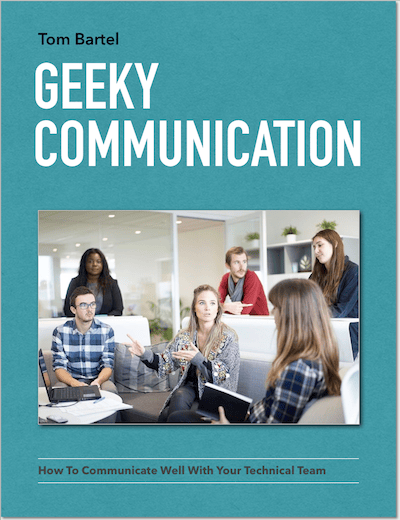Effective one-on-one conversations should produce some insight. Either your employee should learn something he did not know before, or you, as his manager, should learn something you did not know before. Ideally, of course, both would learn something. This learning can be almost anything. Maybe the employee needs to find a new flat until the end of the month and is a bit stressed because of that. Maybe she plays with the thought of moving into a different technological field. Maybe you learn about your employee’s job satisfaction or future plans. Maybe your employee learns something new about the organization. The learning can be about things that happened at work, or, occasionally, about something entirely different.

However, some truths come out more easily than others. Sometimes, neither the manager nor the employee know the truth, and both have to find it together. Sometimes, even, the employee knows the truth, but avoids it, or does not know that he knows it. In these cases, the manager has to “tickle out the truth” by asking a series of clever questions. Let us look at an example.
Meet Ben and Charlie

The situation: Ben is a nice guy, and everybody on his team gets along with him very well. However, there are signs that Ben is not fully engaged with his team’s goals, and he does not take a lot of ownership of his topics. To many people, he appears unmotivated. Charlie, his manager, talks to him about it. He wants to know the reason why Ben is not showing more engagement, and tries to put his questions so that Ben will tell by himself, without being asked directly. Let’s take a peek into one of their one-on-ones:
Charlie: “How do you feel when you think about work on a Sunday night, after a nice weekend?”
Ben: “Well, I like weekends, of course, but I also like my work. So I’m looking forward to getting things done, and to meeting my colleagues again.”
Charlie: “What exactly do you like about your work?”
Ben: “I like the atmosphere on my team, and we are working on some cool features.”
Charlie: “What is the biggest pain point you have about work?”
Ben: (thinks for a bit) “Hm… There is not really a pain point. Can’t think of anything, off the top of my head.”
Charlie: “Let’s consider the opposite: If there was one thing you could change or improve about work, or your working environment, what would that be?”
Ben: “No open space office, probably.”
Let’s take a break here to check what we have accomplished so far. That should be a quick exercise, because we did not accomplish all that much. The conversation has been rather superficial. It was all question-answer, question-answer, and brought no new insights. Ben claims that everything is fine, and, from what he says, there is no problem at all.
Maybe Charlie’s strategy was too direct, or too narrow. It is pretty obvious that his questions are directed at Ben’s motivation in his current job, and they only deal with the here and now. Maybe Ben is a bit cautious with the answers he gives, in order not to say anything that his manager might dislike. Therefore, Charlie varies his strategy a bit and expands the scope of his questions.
Second attempt

Charlie: “In your entire life so far, when was the time when you were most motivated about work?”
Ben: (thinks for a bit) “Hmm… I think that was in a previous job. I liked the technology we were using.”
Charlie: “What were you using?”
Ben: “Oh, you know, nothing super fancy, some NoSQL database, and it was also when CSS animations were getting more and more popular, so I was learning a lot about those. I also liked the product we were working on.”
Charlie: “What did you like about the product?”
Ben: “I thought it was useful. And I was able to add some cool new functionality to it.”
Charlie: “Tell me more about that.”
Ben: “I got the opportunity to develop a prototype for a new analytics tool that complemented one of our products. The company only had a very small development team. There were only five developers in total. And because all of them were tied up in current customer projects, I was the one who got to build the prototype. That really motivated me.”
Charlie: “What exactly was so motivating about it?”
Ben: “Well, first, it was a cool product, and I thought it added value. But the main thing was that I was very free in doing pretty much everything. I had to figure out how to collect the data that was necessary, I had to design a workflow, how to best arrange the different charts and tables. I had a look at competing products and found where they had shortcomings, and what we could do better. I don’t know, I could really make this thing my baby, from head to toe. And I liked that.”
Charlie: “When you compare your job here with that experience, what is missing?”
Ben: (thinks for a bit) “I think sometimes, the tasks that we get are too fine-grained. Everything has already been planned through, all the interesting decisions have been made. We just implement it, and yes, delivering high-quality code that is robust, flexible, maintainable, and so on, is a challenge in itself, and also requires creativity. I just miss being creative with the user-facing aspects sometimes, and giving input to that.”
This conversation gives us a lot more insight, and it gives Charlie something to work with: In his current position, Ben seems to lack the autonomy he needs to be motivated. He finds the topics that he gets to work on too narrow.
What happened here?

How did Charlie achieve this new insight? There are a couple of things to note about this conversation:
- Charlie steered the conversation’s focus away from the current situation in their company, and asked Ben to reflect on his entire professional life. This can take some of the pressure away and shows Ben that Charlie truly wants to learn something about him.
- When asked why he was so motivated in his previous job, Ben initially came up with some rather random answers. At first, the technology was the reason, even though that was pretty standard. Then, he claims his motivation had been due to the useful product. However, Charlie keeps digging deeper, and, by making Ben think more about it, something more substantial comes up: Ben enjoyed a lot of autonomy and freedom in that job.
- Did you notice the little trick? After Ben described his most motivating work experience, Charlie did not ask if there was something missing in his current job. Instead, he asked straight away: “What is missing?” Like it was very obvious that something must be missing (and, to Charlie, it is, but Ben doesn’t know that). By answering, Ben admits - or recognizes - that something is indeed missing. Charlie succeeded in holding up the mirror for Ben, so that Ben could take a better look at his own situation.
Conclusion
I think the takeaway from this little example should be that it is not only the questions that matter, but also how you use them to dig deeper. I am a huge fan of Jason Evanish’s work, and his list of one-on-one questions is simply great. However, these questions can only serve as entry points to start some topic. If you want to get to the bottom of things, you have to ask follow-up questions, and do so relentlessly until you really find the root cause.
Jason frequently quotes former Intel CEO Andy Grove on this, and I will just steal the quote here:
“When the supervisor thinks the subordinate has said all he wants … he should ask another question. He should try to keep the flow of thoughts coming by prompting the subordinate with queries until both feel satisfied they have gotten to the bottom of the problem.”
Deciding which question, out of the many possible ones, to ask next is an art that requires practice and experience. If you master this art, you can become a truly great manager, and your people will be grateful for the insight that you help provide. So keep practicing.
Time investment
I worked on this article for about three hours. Most of it was done on the train to and from work.
Want to learn more on communication? Check this out:

Yours free: An ebook on effective communication!
Get Geeky Communication absolutely free, and learn about effective communication in a technical environment. Just enter your email address below. No spam ever, guaranteed.
 I'm Tom Bartel, Germany-based software developer, engineering manager, speaker, and human communication geek. More
I'm Tom Bartel, Germany-based software developer, engineering manager, speaker, and human communication geek. More